Portal:Sharks/Selected articles
The selected articles are what we believe to be the best articles in Wikipedia related to sharks, so defined because they have reached featured article or good article status.
Usage
- Add a new selected article to the next available subpage, using
{{Portal:Sharks/Selected articles/Layout
|image=(Lead image from article, without Image: or File:. Free images only, please.)
|caption=(Description of image, shown when a cursor is placed over the image.)
|text=(Lead section from the article)
|link=(Link to the article.)}}
- Save the page, remembering to link to the article the lead was taken from for GFDL reasons.
- Create a new subsection for the next addition, if necessary.
- Update "max=" to new total for its {{Random portal component}} on the main page.
Selected articles list
Jersey Shore shark attacks of 1916 {FA}

The Jersey Shore shark attacks of 1916 were a series of shark attacks along the coast of New Jersey between July 1 and July 12, 1916, in which four people were killed and one injured. Since 1916, scholars have debated which shark species was responsible and the number of animals involved, with the great white shark and the bull shark most frequently being blamed. The attacks occurred during a deadly summer heat wave and polio epidemic in the northeastern United States that drove thousands of people to the seaside resorts of the Jersey Shore. Shark attacks on the Atlantic Coast of the United States outside the semitropical states of Florida, Georgia, and the Carolinas were rare, but scholars believe that the increased presence of sharks and humans in the water led to the attacks in 1916.
Local and national reaction to the attacks involved a wave of panic that led to shark hunts aimed at eradicating the population of "man-eating" sharks and protecting the economies of New Jersey's seaside communities. Resort towns enclosed their public beaches with steel nets to protect swimmers. Scientific knowledge about sharks before 1916 was based on conjecture and speculation. The attacks forced ichthyologists to reassess common beliefs about the abilities of sharks and the nature of shark attacks.
The Jersey Shore attacks immediately entered into American popular culture, where sharks became caricatures in editorial cartoons representing danger. The attacks inspired Peter Benchley's novel Jaws (1974), an account of a great white shark that torments the fictional coastal community of Amity. Jaws was made into an influential film in 1975 by Steven Spielberg. The attacks became the subject of documentaries for the History Channel, Discovery Channel, and National Geographic Channel.
Oceanic whitetip shark {FA}
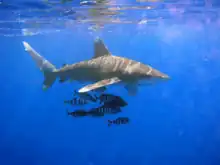
The oceanic whitetip shark, Carcharhinus longimanus, is a large pelagic shark of tropical and warm temperate seas. It is a stocky shark, most notable for its long, white-tipped, rounded fins.
This aggressive but slow-moving fish dominates feeding frenzies, and is a danger to survivors of oceanic shipwrecks and downed aircraft — it has attacked more humans than all other shark species combined. Recent studies have shown that its numbers are in steep decline as its large fins are highly valued as the chief ingredient of shark fin soup and, as with other shark species, the oceanic whitetip faces mounting pressure from fishing throughout its range.
Jaws (film) {FA}

Jaws is a 1975 American horror/thriller film directed by Steven Spielberg (pictured) and based on Peter Benchley's best-selling novel. The police chief of Amity Island, a fictional summer resort town, tries to protect beachgoers from a giant great white shark by closing the beach, only to be overruled by the town council, which wants the beach to remain open to draw a profit from tourists during the summer season. After several attacks, the police chief enlists the help of a marine biologist and a professional shark hunter. Roy Scheider stars as police chief Martin Brody, Richard Dreyfuss as marine biologist Matt Hooper, Robert Shaw as shark hunter Quint, and Lorraine Gary as Brody's wife Ellen.
Jaws is regarded as a watershed film in motion picture history, the father of the summer blockbuster movie and one of the first "high concept" films.[1][2] Due to the film's success in advance screenings, studio executives decided to distribute it in a much wider release than ever before. The Omen followed suit in the summer of 1976 and then Star Wars one year later in 1977, cementing the notion for movie studios to distribute their big-release action and adventure pictures (commonly referred to as tentpole pictures) during the summer. The film was followed by three sequels, none with the participation of Spielberg or Benchley: Jaws 2 (1978), Jaws 3-D (1983) and Jaws: The Revenge (1987). A video game titled Jaws Unleashed was produced in 2006. Despite the high levels of violence in the film due to the graphic depiction of the shark's attacks, it was only rated PG.
Bigeye thresher {GA}

The bigeye thresher, Alopias superciliosus, is a species of thresher shark, family Alopiidae, found in temperate and tropical oceans worldwide. Like other thresher sharks, nearly half its total length consists of the elongated upper lobe of the tail fin. Its common name comes from its enormous eyes, which are placed in keyhole-shaped sockets that allow them to be rotated upward. This species can also be distinguished by a pair of deep grooves on the top of its head, from which its scientific name is derived.
The large eyes of the bigeye thresher are adapted for hunting in low light conditions. It is one of the few sharks that conduct a diel vertical migration, staying in deep water during the day and moving into surface waters at night to feed. To protect its sensitive brain and eyes from the temperature changes accompanying these movements, the bigeye thresher has a vascular exchange system called the rete mirabile around those organs. This species feeds mainly on fish and squid, which are stunned via whip-like strikes of the long tail. Bigeye threshers are ovoviviparous, usually bearing litters of two pups. The embryos are oophagous and feed on ova produced by the mother while inside the uterus. This shark is caught by commercial fisheries across its range; the meat is not highly regarded but the skin, fins, and liver oil are valued. It has been assessed as Vulnerable by the International Union for Conservation of Nature (IUCN).
Blacknose shark {GA}

The blacknose shark, Carcharhinus acronotus, is a species of requiem shark, family Carcharhinidae, common in the tropical and subtropical waters of the western Atlantic Ocean. This species generally inhabits coastal seagrass, sand, or rubble habitats, with adults preferring deeper water than juveniles. A small shark typically measuring 1.3 m (4.1 ft) long, the blacknose shark has a typical streamlined "requiem shark" shape with a long rounded snout, large eyes, and a small first dorsal fin. Its common name comes from a characteristic black blotch on the tip of its snout, though this may be indistinct in older individuals.
Blacknose sharks feed primarily on small bony fishes and cephalopods, and in turn fall prey to larger sharks. Like other members of their family, they exhibit a viviparous mode of reproduction in which the developing embryos are sustained by a placental connection. The females give birth to 3–6 young in late spring or early summer either annually or biennually, after a gestation period of 8–11 months. This species is not known to attack humans, though it has been documented performing a threat display towards divers. It is of moderate commercial and recreational importance. The conservation status of this species has not been assessed by the International Union for Conservation of Nature (IUCN); in 2009, the US National Oceanic and Atmospheric Administration (NOAA) announced that populations of the blacknose shark off the United States are being overfished, and proposed new conservation measures.
Blacktip shark {GA}

The blacktip shark, Carcharhinus limbatus, is a species of requiem shark, family Carcharhinidae. It is common to coastal tropical and subtropical waters around the world, including brackish habitats. Genetic analyses have revealed substantial variation within this species, with populations from the western Atlantic Ocean isolated and distinct from those in the rest of its range. The blacktip shark has a stout, fusiform body with a pointed snout, long gill slits, and no ridge between the dorsal fins. Most individuals have black tips or edges on the pectoral, dorsal, pelvic, and caudal fins. It attains a maximum length of 2.8 m (9.0 ft).
Swift, energetic piscivores, blacktip sharks are known to make spinning leaps out of the water while attacking schools of small fish. Their demeanor has been described as "timid" compared to other large requiem sharks. Both juveniles and adults form groups of varying size. Like other members of its family, the blacktip shark is viviparous; females bear 1–10 pups every other year. Young blacktip sharks spend the first months of their lives in shallow nurseries, and grown females will return to the nurseries where they were born to give birth themselves. In the absence of males, females are also capable of asexual reproduction. Normally wary of humans, blacktip sharks can become aggressive in the presence of food and have been responsible for a number of attacks on people. This species is of importance to both commercial and recreational fisheries across many parts of its range, with its meat, skin, fins, and liver oil utilized. It has been assessed as Near Threatened by the World Conservation Union, on the basis of its low reproductive rate and level of human exploitation.
Caribbean reef shark {GA}
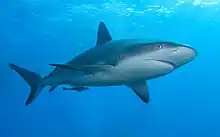
The Caribbean reef shark (Carcharhinus perezi, often misspelled perezii) is a species of requiem shark, family Carcharhinidae. It is found in the tropical waters of the western Atlantic Ocean from Florida to Brazil, and is the most commonly encountered reef shark in the Caribbean. With a robust, streamlined body typical of the requiem sharks, this species is difficult to tell apart from other large members of its family such as the dusky shark (C. obscurus) and the silky shark (C. falciformis). Distinguishing characteristics include dusky-colored fins without prominent markings, a short free rear tip on the second dorsal fin, and tooth shape and number.
Measuring up to 3 m (10 ft) long, the Caribbean reef shark is one of the largest apex predators in the reef ecosystem, feeding on a variety of fishes and cephalopods. They have been documented resting motionless on the sea bottom or inside caves, unusual behavior for an active-swimming shark. If threatened, it may perform a threat display in which it frequently changes direction and dips its pectoral fins. Like other requiem sharks, it is viviparous with females giving birth to 4–6 young every other year. Caribbean reef sharks are of some importance to fisheries as a source of meat, leather, liver oil, and fishmeal, but recently they have become more valuable as an ecotourist attraction. In the Bahamas and elsewhere, bait is used to attract them to groups of divers in controversial "shark feedings". This species is responsible for a small number of attacks on humans.
Common thresher {GA}

The common thresher, Alopias vulpinus, is a species of thresher shark, family Alopiidae, found in tropical and temperate waters worldwide. The largest member of its family, this species may attain a length of 6 m (18 ft), half of which consists of the long upper lobe of its tail fin. The common thresher is often confused with the similar-looking pelagic thresher (Alopias pelagicus), from which it can be distinguished by the white band over its pectoral fins.
This shark is an active, fast-swimming predator that is capable of maintaining a higher body temperature than the surrounding sea water. Its long tail is used in a whip-like fashion to stun its prey, mostly small schooling forage fish. Like other mackerel sharks, it has an ovoviviparous mode of reproduction and gives birth to live young. The common thresher is commercially important in many parts of the world: the meat and fins are sold for human consumption, the skin is made into leather, and the liver oil is processed for vitamins. This species is also valued by recreational anglers as it is an exceptionally strong fighter on hook-and-line. As a result of increasing exploitation, the common thresher was assessed as Vulnerable by the International Union for Conservation of Nature (IUCN) in 2007.
Crocodile shark {GA}
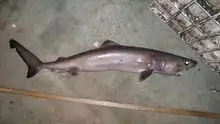
The crocodile shark, Pseudocarcharias kamoharai, is a species of shark found worldwide in tropical waters. It is the only member of the family Pseudocarcharidae. The crocodile shark is the smallest living mackerel shark, measuring only 1 m (3 ft) long, and can be distinguished by its elongated body, extremely large eyes, and relatively small fins. It is a specialized inhabitant of the open ocean, feeding on pelagic fishes and invertebrates. The size and structure of its eyes indicates that it is adapted for hunting at night. The crocodile shark is ovoviviparous and typically gives birth to litters of four. The fetuses are oophagous, meaning that they feed on eggs produced by the mother. Due to its small size, the crocodile shark is of little commercial importance. However, it is caught in substantial numbers as bycatch, leading it to be assessed as Near Threatened by the World Conservation Union. This species was responsible for damaging deep sea fiberoptic cables when the technology was first deployed in 1985.
Dusky shark {GA}
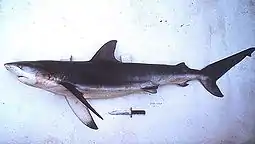
The dusky shark, Carcharhinus obscurus, is a species of requiem shark, family Carcharhinidae, occurring in tropical and warm-temperate continental seas worldwide. A generalist apex predator, the dusky shark can be found from the coast to the outer continental shelf and adjacent pelagic waters, and has been recorded from a depth of 400 m (1,300 ft). Populations migrate seasonally towards the poles in the summer and towards the equator in the winter, traveling hundreds to thousands of kilometers. One of the largest members of its genus, the dusky shark reaches 4.2 m (14 ft) in length and 347 kg (765 lb) in weight. It has a slender, streamlined body and can be identified by its short round snout, long sickle-shaped pectoral fins, ridge between the first and second dorsal fins, and faintly marked fins.
Adult dusky sharks have a broad and varied diet, consisting mostly of bony fishes, sharks and rays, and cephalopods, but also occasionally crustaceans, sea stars, bryozoans, sea turtles, marine mammals, carrion, and garbage. This species is viviparous with a three-year reproductive cycle; females bear litters of 3–14 young after a gestation period of 22–24 months, after which there is a year of rest before they become pregnant again. Females are capable of storing sperm for long periods, as their encounters with suitable mates may be few and far between due to their nomadic lifestyle and low overall abundance. Dusky sharks are one of the slowest-growing and latest-maturing sharks, not reaching adulthood until around 20 years of age.
Because of its slow reproductive rate, the dusky shark is very vulnerable to human-caused population depletion. This species is highly valued by commercial fisheries for its fins, used in shark fin soup, and for its meat, skin, and liver oil. It is also esteemed by recreational fishers. The World Conservation Union has assessed this species as Near Threatened worldwide and Vulnerable off the eastern United States, where populations have dropped to 15–20% of 1970s levels. The dusky shark is regarded as potentially dangerous to humans due to its large size, but there are few attacks attributable to it.
Epaulette shark {GA}
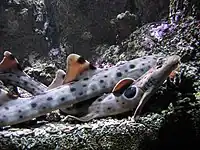
The epaulette shark, Hemiscyllium ocellatum, is a species of longtailed carpet shark, family Hemiscylliidae, found in shallow, tropical waters off Australia and New Guinea (and possibly elsewhere). The common name of this shark comes from the very large, white-margined black spot behind each pectoral fin, which are reminiscent of military epaulettes. A small species usually under 1 m (3.3 ft) long, the epaulette shark has a slender body with a short head and broad, paddle-shaped paired fins. The caudal peduncle (to which the tail fin is attached) comprises over half the shark's length. Adults are light brown above, with scattered darker spots and indistinct saddles.
Epaulette sharks have nocturnal habits and frequent shallow water on coral reefs or in tidal pools. This shark has evolved to cope with the severe nighttime oxygen depletion (hypoxia) in isolated tidal pools by increasing the blood supply to its brain and selectively shutting down non-essential neural functions. It is capable of surviving complete anoxia for an hour without ill effects, and at a much higher temperature than most other hypoxia-tolerant animals. Rather than swim, epaulette sharks "walk" by wriggling their bodies and pushing with their paired fins. This species feeds on a wide range of small benthic invertebrates and bony fishes. Epaulette sharks are oviparous, with females depositing pairs of egg capsules around every 14 days from August to December. Due to their hardiness and small size, epaulette sharks are popular with both public and home aquaria. The World Conservation Union has assessed this species as of Least Concern, as outside of the small aquarium trade it is of little interest to fisheries.
Finetooth shark {GA}

The finetooth shark, Carcharhinus isodon, is a species of requiem shark, family Carcharhinidae, found in the western Atlantic Ocean from North Carolina to Brazil. It forms large schools in shallow, coastal waters and migrates seasonally following warm water. A relatively small, slender-bodied shark, the finetooth shark can be identified by its needle-like teeth, dark blue-gray dorsal coloration, and long gill slits. It attains a maximum length of 1.9 m (6.2 ft). The diet of this species consists primarily of small bony fishes, in particular menhaden. Like other members of its family, it is viviparous in reproduction; every other year, females give birth to 2–6 pups in estuarine nursery areas. The finetooth shark is important to the gillnet shark fishery operating off the southeastern United States; the meat is sold for human consumption. Its population has not yet been depleted, but the US National Marine Fisheries Service (NMFS) has determined that fishing is occurring at unsustainable levels.
Galapagos shark {GA}
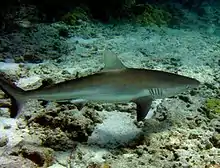
The Galapagos shark, Carcharhinus galapagensis, is a species of requiem shark, family Carcharhinidae, found worldwide. This species favors clear reef environments around oceanic islands, where it is often the most abundant shark species. A large species that grows to 3.7 m (12 ft), the Galapagos reef shark has a typical fusiform "reef shark" shape and is very difficult to distinguish from the dusky shark (C. obscurus) and the grey reef shark (C. amblyrhynchos). An identifying character of this species is its tall first dorsal fin, which has a slightly rounded tip and originates over the rear tips of the pectoral fins.
Galapagos sharks are active predators often encountered in large groups. They feed mainly on bottom-dwelling bony fishes and cephalopods; larger individuals have a much more varied diet, consuming other sharks, marine iguanas, sea lions, and even garbage. As in other requiem sharks, reproduction is viviparous, with females bearing litters of 4–16 pups every 2–3 years. The juveniles tend to remain in shallow water to avoid predation by the adults. Galapagos sharks are bold and have behaved aggressively towards humans, and are thus regarded as dangerous. The World Conservation Union has assessed this species as Near Threatened, as it has a slow reproductive rate and there is heavy fishing pressure across its range.
Great hammerhead {GA}
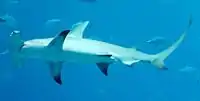
The great hammerhead, Sphyrna mokarran, is the largest of the hammerhead sharks (family Sphyrnidae), attaining a maximum length of 6.1 m (20 ft). It is found in tropical and warm temperate waters worldwide, inhabiting coastal areas and the continental shelf. The great hammerhead can be distinguished from other hammerheads by the shape of its "hammer" (called the "cephalofoil"), which is wide with an almost straight front margin, and by its tall, sickle-shaped first dorsal fin. A solitary, strong-swimming apex predator, the great hammerhead feeds on a wide variety of prey ranging from crustaceans and cephalopods, to bony fishes, to smaller sharks. Observations of this species in the wild suggest that the cephalofoil functions to immobilize stingrays, a favored prey. This species has a viviparous mode of reproduction, bearing litters of up to 55 pups every two years.
Although potentially dangerous, the great hammerhead rarely attacks humans. It sometimes behaves inquisitively toward divers and should be treated with respect. This shark is heavily fished for its large fins, which are extremely valuable on the Asian market as the main ingredient of shark fin soup. As a result, great hammerhead populations are declining substantially worldwide, and it has been assessed as Endangered by the World Conservation Union.
Grey reef shark {GA}
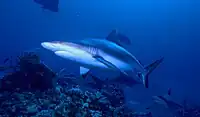
The grey reef shark, Carcharhinus amblyrhynchos (sometimes misspelled amblyrhynchus or amblyrhinchos), is a species of requiem shark, family Carcharhinidae. what One of the most common reef sharks in the Indo-Pacific, it is found as far east as Easter Island and as far west as South Africa. This species is most often seen in shallow water near the drop-offs of coral reefs. The grey reef shark has a typical "reef shark" shape with a broad, round snout and large eyes. This species can be distinguished from similar species by the plain or white-tipped first dorsal fin, the dark tips on the other fins, the broad black rear margin on the tail fin, and the lack of a ridge between the dorsal fins. Most individuals are less than 1.9 m (6.2 ft) long.
Grey reef sharks are fast-swimming, agile predators that feed primarily on free-swimming bony fishes and cephalopods. Their aggressive demeanor enables them to dominate many other shark species on the reef, despite their moderate size. Many grey reef sharks have a home range on a specific area of the reef, to which they will return time and again. However, they are not territorial but rather quite social. During the day, these sharks often form aggregations of 5–20 individuals near coral reef drop-offs, and then split up in the evening as the sharks begin to hunt. Adult female grey reef sharks also form groups in very shallow water, where the higher water temperature may accelerate their growth or that of their unborn young. Like other members of its family, the grey reef shark is viviparous, meaning that the mother nourishes her embryos through a placental connection. Litters of 1–6 pups are born every other year.
Grey reef sharks were the first shark species known to perform a threat display, a stereotyped behavior warning that it is prepared to attack. The display involves a "hunched" posture with characteristically dropped pectoral fins, and an exaggerated, side-to-side swimming motion. Grey reef sharks will often perform the display if they are followed or cornered by divers to indicate that they perceive a threat. This species has been responsible for a number of attacks on humans and should be treated with caution, especially if they begin to display. Grey reef sharks are caught by many fisheries and are susceptible to local population depletion due to their low reproductive rate and limited dispersal. As a result, the World Conservation Union has assessed this species as Near Threatened.
Horn shark {GA}

The horn shark, Heterodontus francisci, is a species of bullhead shark, family Heterodontidae. It is endemic to the coastal waters off the western coast North America, from California to the Gulf of California. Young sharks are segregated spatially from the adults, with the former preferring deeper sandy flats and the latter preferring shallower rocky reefs or algal beds. A small species typically measuring 1 m (3.3 ft) in length, the horn shark can be recognized by a short, blunt head with ridges over its eyes, two high dorsal fins with large venomous spines, and a brown or gray coloration with many small dark spots.
Slow-moving, generally solitary predators, horn sharks hunt at night inside small home ranges and retreat to a favored shelter during the day. Their daily activity cycles are controlled by environmental light levels. Adult sharks prey mainly on hard-shelled molluscs, echinoderms, and crustaceans, which they crush between powerful jaws and molar-like teeth, while also feeding opportunistically on a wide variety of other invertebrates and small bony fishes. Juveniles prefer softer-bodied prey such as polychaete worms and sea anemones. The shark extracts its prey from the substrate using suction and, if necessary, levering motions with its body. Reproduction is oviparous, with females laying up to 24 eggs from February to April. After laying, the female picks up the auger-shaped egg cases and wedges them into crevices to protect them from predators.
Horn sharks are harmless unless harassed, and are readily maintained in captivity. They are not targeted by either commercial or recreational fisheries, though small numbers are caught as bycatch. In Mexico this species is used for food and fishmeal, and in California its spines are made into jewelry. The International Union for Conservation of Nature (IUCN) does not yet have enough information to determine the horn shark's conservation status. It faces few threats off the coast of the United States.
Jaws 2 {GA}
Jaws 2 is a 1978 horror thriller film and the first sequel to Steven Spielberg's 1975's Jaws. Directed by Jeannot Szwarc and starring Roy Scheider (pictured) as Police Chief Martin Brody who must deal with another Great White Shark terrorizing the waters of Amity Island.
Like the first film, the production of Jaws 2 was troubled. The original director, John D. Hancock, proved to be unsuitable for an action film and was replaced by Szwarc. Scheider, who later claimed to have only reprised his role to end a contractual issue with Universal, was also unhappy during production and had several heated exchanges with Szwarc.
However, Jaws 2 became the highest-grossing sequel in history at the time of its release in 1978 (though only kept this record for two years until the release of The Empire Strikes Back in 1980) and remained in the all-time Top 25 for more than two decades. The film's tagline, "Just when you thought it was safe to go back in the water...", became one of the most famous in movie history and has been parodied and homaged several times. Although there would be two further films in the series, Jaws 2 is generally regarded as the best of the sequels.
Jaws 3-D {GA}

Jaws 3-D (also known as Jaws 3) is an 1983 horror–thriller film directed by Joe Alves and starring Dennis Quaid (pictured). It is the second sequel to 1975's Jaws.
As SeaWorld, a water park with underwater tunnels and lagoons, prepares for opening, a young great white shark infiltrates the park from the sea, seemingly attacking and killing water skiers and park employees. Once the baby shark is captured, it becomes apparent that it was the mother, a much larger shark who also entered the park, who was the real killer.
The film is notable for making use of 3-D film during the revived interest in the technology in the 1980s, amongst other horror films such as Friday the 13th Part III and Amityville 3-D. Cinema audiences could wear disposable cardboard polarized glasses to create the illusion that elements penetrate the screen. Several shots and sequences were designed to utilise the effect, such as the shark's destruction. Since the 3-D is ineffective in home viewing, the alternative title Jaws III is used for television broadcasts, VHS and DVD.
Jaws: The Revenge {GA}

Jaws: The Revenge (a.k.a. Jaws 4) is a 1987 horror–thriller film directed by Joseph Sargent. It is the third and final sequel to Steven Spielberg's Jaws.
The film focuses on Ellen Brody's (Lorraine Gary) convictions that the shark is stalking her family, especially when a great white shark follows her to the Bahamas. Jaws: The Revenge was shot on location in New England and in the Caribbean, and completed on the Universal lot. Like the first two films of the series, Martha's Vineyard was the location of the fictional Amity Island for the opening scenes of the film.
The film received a poor critical reception, and earned the lowest amount of money from the franchise. It is considered by film critics to be one of the worst movies ever made.
Kitefin shark {GA}

The kitefin shark or seal shark, Dalatias licha, is a species of dogfish shark in the family Dalatiidae, and the only species in its genus. It is found sporadically around the world, usually close to the sea floor at depths of 200–600 m (660–2,000 ft). This shark has a slender body with a very short, blunt snout, large eyes, and thick lips. Its teeth are highly differentiated between the upper and lower jaws, with the upper teeth small and narrow and the lower teeth large, triangular, and serrated. Its typical length is 1.0–1.4 m (2.5–4.0 ft).
With a sizable oil-filled liver to maintain neutral buoyancy, the kitefin shark is able to cruise slowly through the water while expending little energy. Armed with large teeth and a strong bite, it is a powerful, solitary predator that takes many different types of prey, ranging from bony fishes, sharks and rays, to cephalopods, crustaceans, polychaete worms, siphonophores, and possibly carrion. It also takes bites out of animals larger than itself, similar to its smaller relative, the cookiecutter shark (Isistius brasiliensis). This shark is ovoviviparous and gives birth to 10–14 young. The kitefin shark is fished commercially for its meat, skin, and liver oil, primarily by Portugal and Japan. A fishery targeting this species existed off the Azores from the 1970s to the 1990s, but collapsed due to overfishing and falling liver oil prices; the rapid depletion of the Azores stock is often cited as an example of the susceptibility of deep-sea sharks to human exploitation. The World Conservation Union does not yet have sufficient data to assess the global conservation status of this species.
Leopard shark {GA}
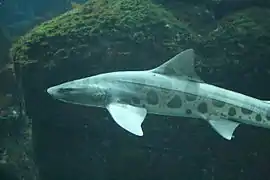
The leopard shark, Triakis semifasciata, is a species of houndshark, family Triakidae, found along the Pacific coast of North America from the U.S. state of Oregon to Mazatlán in Mexico. Typically measuring 1.2–1.5 m (3.9–4.9 ft) long, this slender-bodied shark is immediately identifiable by the striking pattern of black saddle-like markings and large spots over its back, from which it derives its common name. Large schools of leopard sharks are a common sight in bays and estuaries, swimming over sandy or muddy flats or rock-strewn areas near kelp beds and reefs. They are most common near the coast, in water less than 4 m (13 ft) deep.
Active-swimming predators, groups of leopard sharks often follow the tide onto intertidal mudflats to forage for food, mainly clams, spoon worms, crabs, shrimp, bony fish, and fish eggs. Most leopard sharks tend to remain within a particular area rather than undertaking long movements elsewhere, which has led to genetic divergence between populations of sharks living in different regions. This species is ovoviviparous, meaning that the young hatch inside the uterus and are nourished by a yolk sac. From March to June, the female gives birth to as many as 37 young after a gestation period of 10–12 months. This shark is relatively slow-growing and takes many years to mature.
Harmless to humans, the leopard shark is caught by commercial and recreational fisheries for food and the aquarium trade. This species is mostly fished in the waters off California where, after a period of population decline in the 1980s, new fishing regulations in the early 1990s reduced harvesting to sustainable levels. The International Union for Conservation of Nature has assessed this species as Conservation Dependent, as local stocks may easily become overfished due to the shark's slow growth and limited migratory habits.
Longfin mako shark {GA}

The longfin mako shark, Isurus paucus, is a species of mackerel shark in the family Lamnidae, with a probable worldwide distribution in temperate and tropical waters. An uncommon species, it is commonly lumped together under the name "mako" with its better-known relative, the shortfin mako shark (I. oxyrinchus). The longfin mako is a pelagic species found in moderately deep water, having been reported to a depth of 220 m (720 ft). Growing to a maximum length of 4.3 m (14 ft), the slimmer build and long, broad pectoral fins of this shark suggest that it is a slower and less active swimmer than the shortfin mako.
Longfin mako sharks are predators that feed on small schooling bony fishes and cephalopods. It is uncertain whether this shark is capable of elevating its body temperature above that of the surrounding water like the other members of its family, though it possesses the requisite physiological adaptations. Reproduction in this species is ovoviviparous, meaning that the embryos hatch from eggs inside the uterus. In the latter stages of development, the unborn young are fed non-viable eggs by the mother (oophagy). The litter size is typically two but may be as many as eight. The longfin mako is of limited commercial value as its meat and fins are of lower quality than those of other pelagic sharks; it is caught unintentionally in low numbers across its range. The World Conservation Union has assessed this species as Vulnerable due to its rarity, low reproductive rate, and continuing bycatch mortality.
Megalodon {GA}

The megalodon (/ˈmɛɡələdɒn/ MEG-ə-lə-don; from Greek: μέγας ὀδούς, "big tooth"), Carcharodon megalodon or Carcharocles megalodon (in dispute), was a giant shark that lived in prehistoric times. The oldest remains of this species found are about 18 million years old and C. megalodon became extinct in the Pleistocene epoch probably about 1.5 million years ago. It was the apex predator of its time and is the largest carnivorous fish known to have existed.
C. megalodon could grow more than 18 metres (59 ft) long and is also quite possibly the largest shark ever to exist. From scrutiny of its remains, scientists conclude that C. megalodon belongs to the order Lamniformes. However, scientists are still debating which genus would be most appropriate for C. megalodon from the two proposed. Fossil evidence has revealed that megalodon fed upon large marine animals.
Nursehound {GA}
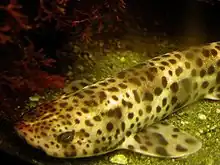
The nursehound, large-spotted dogfish, greater spotted dogfish, or bull huss, Scyliorhinus stellaris, is a species of catshark, family Scyliorhinidae, found in the northeastern Atlantic Ocean. It is generally found amongst rocks or algae at a depth of 20–60 m (66–197 ft). The nursehound shares its range with the more common and closely related small-spotted catshark (S. canicula), which it resembles in appearance but can be distinguished from in having larger spots and nasal skin flaps that do not extend to the mouth. The maximum reported length of this species is 1.6 m (5.2 ft).
Nursehounds have nocturnal habits and generally hide inside small holes during the day, often associating with other members of its species. A benthic predator, it feeds on a range of bony fishes, smaller sharks, crustaceans, and cephalopods. Like other catsharks, the nursehound is oviparous in reproduction. Females deposit large, thick-walled egg cases, two at a time, from March to October, securing them to bunches of seaweed. The eggs take 7–12 months to hatch. Nursehounds are marketed as food in several European countries under various names, including "flake", "catfish", "rock eel", and "rock salmon". It was once also valued for its rough skin (called "rubskin"), which was used as an abrasive. The conservation status of this species has not yet been evaluated by the International Union for Conservation of Nature (IUCN).
Pacific angelshark {GA}

The Pacific angelshark, Squatina californica, is a species of angel shark, family Squatinidae, found in the eastern Pacific Ocean from Alaska to the Gulf of California, and from Ecuador to Chile, although those in the Gulf of California and southeastern Pacific may in fact be separate species. The Pacific angelshark inhabits shallow, coastal waters on sandy flats, usually near rocky reefs, kelp forests, or other underwater features. This species resembles other angel sharks in appearance, with a flattened body and greatly enlarged pectoral and pelvic fins. Characteristic features of this shark include a pair of cone-shaped barbels on its snout, angular pectoral fins, and a brown or gray dorsal coloration with many small dark markings. It attains a maximum length of 1.5 m (4.9 ft).
An ambush predator, Pacific angelsharks conceal themselves on the sea floor and wait for approaching prey, primarily bony fishes and squid. Prey are targeted visually and, with a quick upward thrust of the head, snatched in protrusible jaws. Individual sharks actively choose ideal ambush sites, where they remain for several days before moving on to a new one. This species is more active at night than during the day, when it stays buried in sediment and seldom moves. Reproduction is ovoviviparous, meaning that the embryos hatch inside the mother's uterus and are sustained by a yolk sac until birth. Females give birth to an average of six young every spring.
Pacific angelsharks are not dangerous to humans unless provoked, in which case their bite can cause a painful injury. They are valued for their meat and are captured by commercial and recreational fishers across their range. A targeted gillnet fishery for this species began off Santa Barbara, California in 1976 and ended in 1994, after overfishing and new regulations led to its near-collapse. This species is now mainly fished in Mexican waters. The World Conservation Union has assessed this species as Near Threatened, as the Californian population is largely protected and recovering, while the impact of Mexican fisheries is unknown.
Pelagic thresher {GA}
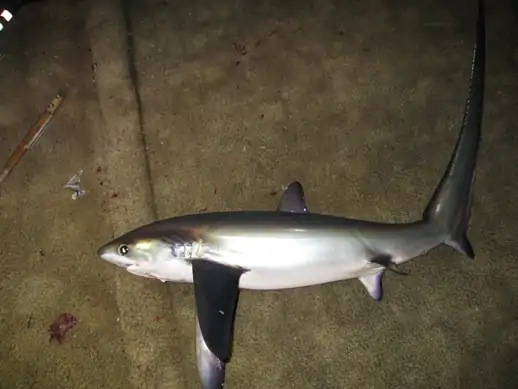
The pelagic thresher, Alopias pelagicus, is a species of thresher shark, family Alopiidae; this group of sharks are characterized by the greatly elongated upper lobes of their caudal fins. The pelagic thresher occurs in the tropical and subtropical waters of the Indian and Pacific Oceans, usually far from shore but occasionally entering coastal habitats. It is often confused with the common thresher (A. vulpinus), even in professional publications, but can be distinguished by the dark, rather than white, color over the bases of its pectoral fins. The smallest of the three thresher species, the pelagic thresher typically measures 3 m (10 ft) long.
The diet of the pelagic thresher consists mainly of small midwater fishes, which are stunned with whip-like strikes of their tails. Along with all other mackerel sharks, the pelagic thresher exhibits ovoviviparity and usually gives birth to litters of two. The developing embryos are oophagous, feeding on unfertilized eggs produced by the mother. The young are born unusually large, up to 43% the length of the mother. Pelagic threshers are valued by commercial fisheries for their meat, skin, liver oil, and fins, and are also pursued by sport fishers. The International Union for Conservation of Nature (IUCN) assessed this species as Vulnerable in 2007.
Sicklefin lemon shark {GA}

The sicklefin lemon shark or sharptooth lemon shark, Negaprion acutidens, is a species of requiem shark, family Carcharhinidae, widely distributed in the tropical waters of the Indo-Pacific. It is closely related to the better-known lemon shark (N. brevirostris) of the Americas; the two species are almost identical in appearance, both being stout-bodied sharks with broad heads, two dorsal fins of nearly equal size, and a plain yellow-tinged coloration. As its common name suggests, the sicklefin lemon shark differs from its American counterpart in having more falcate (sickle-shaped) fins. This large species grows up to 3.8 m (12 ft) long. It generally inhabits water less than 92 m (302 ft) deep in a variety of habitats, from mangrove estuaries to coral reefs.
A slow-moving predator feeding mainly on bony fishes, the sicklefin lemon shark seldom travels long distances and many individuals can be found year-round at certain locations. Like other members of its family, this species is viviparous with females giving birth to as many as 13 pups every other year, following a gestation period of 10–11 months. Although they are potentially dangerous to humans and known to respond vigorously to any provocation, under normal circumstances sicklefin lemon sharks are cautious and tend to retreat if approached. The International Union for Conservation of Nature (IUCN) has assessed this species as Vulnerable; its low reproductive productivity and rate of movement limits the capacity of depleted stocks to recover. Off India and Southeast Asia, this species has been severely depleted or extirpated by unregulated exploitation for its meat, fins, and liver oil.
Silvertip shark {GA}

The silvertip shark, Carcharhinus albimarginatus, is a large species of requiem shark found in the tropical Indian and Pacific Oceans. This species is often encountered around offshore islands and coral reefs, and has been known to dive to a depth of 800 m (2,600 ft). The silvertip shark resembles a larger, bulkier grey reef shark (C. amblyrhynchos), and can be easily identified by the prominent white margins on its fins. It attains a maximum length of 3 m (10 ft).
An aggressive, powerful apex predator, the silvertip shark feeds on a wide variety of bony fishes, as well as eagle rays, smaller sharks, and cephalopods. This species dominates other requiem sharks of equal size when competing for food, and larger individuals are often heavily scarred from conflicts with others of its species. As with other members of its family, the silvertip shark is viviparous, with females giving birth to 1–11 pups in the summer. Silvertip sharks are regarded as potentially dangerous to humans, as they often approach divers quite closely. This species is taken by commercial fisheries for its meat and fins, though there is currently insufficient data for the World Conservation Union to assess its conservation status.
Smalltooth sand tiger {GA}

The smalltooth sand tiger or bumpytail ragged-tooth, Odontaspis ferox, is a species of sand shark, family Odontaspididae, with a patchy but worldwide distribution in tropical and warm temperate waters. They usually inhabit deepwater rocky habitats, though they are occasionally encountered in shallow water, and have been known to return to the same location year after year. This rare species is often mistaken for the much more common grey nurse shark (Carcharias taurus), from which it can be distinguished by its first dorsal fin, which is larger than the second and placed further forward. It grows to at least 4.1 m (13.5 ft) in length.
Very little is known of the biology and behavior of the smalltooth sand tiger. It is an active predator of benthic bony fishes, invertebrates, and cartilaginous fishes. This species is thought to be ovoviviparous with oophagous embryos like other mackerel sharks. In contrast to its formidable size and appearance, this shark is harmless, having never been known to behave aggressively towards humans. There is concern that its numbers are declining due to human activities in the Mediterranean and elsewhere, though existing data is inadequate for a full assessment of its conservation status.
Smooth hammerhead {GA}
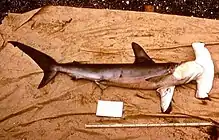
The smooth hammerhead, Sphyrna zygaena, is a species of hammerhead shark, family Sphyrnidae, so named because of the distinctive shape of the head, which is flattened and laterally extended into a hammer shape (called the "cephalofoil"), without an indentation in the middle of the front margin (hence "smooth"). Unlike other hammerheads, this species prefers temperate waters and occurs worldwide at medium latitudes. In the summer, these sharks migrate towards the poles following cool water masses, sometimes forming schools numbering in the hundreds to thousands.
The second-largest hammerhead shark, the smooth hammerhead can measure up to 5 m (16 ft) long. It is an active predator that takes a wide variety of bony fishes and invertebrates, with larger individuals also feeding on sharks and rays. As in the rest of its family, this shark is viviparous and gives birth to litters of 20–40 pups. A relatively common shark, it is captured, intentionally or otherwise, by many commercial fisheries throughout its range; its fins are extremely valuable for use in shark fin soup. This shark is potentially dangerous and has likely been responsible for a few attacks on humans, though it is less likely to encounter swimmers than other large hammerhead species due to its temperate habitat.
Spinner shark {GA}

The spinner shark, Carcharhinus brevipinna, is a species of requiem shark, family Carcharhinidae, named for the spinning leaps it makes as a part of its feeding strategy. This species occurs in tropical and warm temperate waters worldwide, except for in the eastern Pacific Ocean. It is found from coastal to offshore habitats to a depth of 100 m (330 ft), though it prefers shallow water. The spinner shark resembles a larger version of the blacktip shark (C. limbatus), with a slender body, long snout, and black-marked fins. This species can be distinguished from the blacktip shark by the first dorsal fin, which has a different shape and is placed further back, and by the black tip on the anal fin (in adults only). It attains a maximum length of 3 m (10 ft).
Spinner sharks are swift and gregarious predators that feed on a wide variety of small bony fishes and cephalopods. When feeding on schools of forage fish, they will speed vertically through the school while spinning on their axis, erupting from the water at the end. Like other members of its family, the spinner shark is viviparous, with females bearing litters of 3–20 young every other year. The newborns are born in shallow nursery areas near the coast, and are relatively fast-growing. This species is not usually dangerous to humans but may become belligerent when excited by food. Spinner sharks are valued by commercial fisheries across their range for their meat, fins, liver oil, and skin. They are also esteemed as strong fighters by recreational fishers. The World Conservation Union has assessed this species as Near Threatened worldwide and Vulnerable off the southeastern United States.
Angelshark {GA}
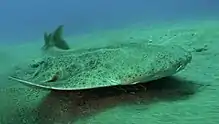
The angelshark, Squatina squatina, is a species of angel shark, family Squatinidae, once widespread in the coastal waters of the northeastern Atlantic Ocean. Well-adapted for camouflaging itself on the sea floor, the angelshark has a flattened form with enlarged pectoral and pelvic fins, giving it a superficial resemblance to a ray. This species can be identified by its broad and stout body, conical barbels, thornless back (in larger individuals), and grayish or brownish dorsal coloration with a pattern of numerous small light and dark markings (that is more vivid in juveniles). It measures up to 2.4 m (7.9 ft) long.
Like other members of its family, the angelshark is a nocturnal ambush predator that buries itself in sediment and waits for passing prey, mostly benthic bony fishes but also skates and invertebrates. An ovoviviparous species, females bear litters of 7–25 pups every other year. The angelshark normally poses little danger to humans, though if provoked it is quick to bite. Used for food since at least Ancient Greece, this shark is often sold on European markets under the name "monkfish". Since the mid-20th century, high levels of commercial fishing across the angelshark's range have decimated its population via bycatch – it is now locally extinct or nearly so across most of its northern range, and the prospects of the remaining fragmented subpopulations are made more precarious by its low reproductive rate. As a result, the International Union for Conservation of Nature (IUCN) has assessed this species as Critically Endangered.
Tawny nurse shark {GA}

The tawny nurse shark, Nebrius ferrugineus, is a species of nurse shark, family Ginglymostomatidae, and the only extant member of the genus Nebrius. It is found widely along coastlines in the Indian and Pacific Oceans, preferring reefs, sandy flats, and seagrass beds from very shallow water to a depth of 70 m (230 ft). With a cylindrical body and a broad, flattened head, the tawny nurse shark is quite similar in appearance to the nurse shark (Ginglymostoma cirratum) of the Americas, from which it can be distinguished by its pointed-tipped dorsal fins and narrow, sickle-shaped pectoral fins. The maximum recorded length is 3.2 m (10.5 ft).
Nocturnal animals, tawny nurse sharks tend to spend the day resting in piles of two dozen or more individuals inside caves or under ledges. At night, they are active-swimming predators that use a powerful suction force to extract prey from inside holes and crevices. The diet of the tawny nurse shark consists mainly of octopus, though they also take other invertebrates, small bony fishes, and rarely sea snakes. This species is ovoviviparous, meaning the embryos hatch from egg capsules inside the mother. It is the only carpet shark in which the embryos are oophagous, feeding on eggs produced by the mother while inside the uterus. The litter size may be as small as one or two, based on the large size of near-term embryos.
Compared to the nurse shark, the tawny nurse shark has a more placid disposition and will often allow divers to touch and play with it. However, it should be accorded respect due to its powerful jaws and sharp teeth. This species is caught by commercial fisheries across most of its range for meat, fins, liver oil, leather, and fishmeal. It is also esteemed as a game fish off Queensland, Australia, and is known for its habit of spitting water in the faces of its captors. The World Conservation Union has assessed this species as Vulnerable.
Velvet belly lantern shark {GA}

The velvet belly lantern shark (or simply velvet belly), Etmopterus spinax, is a species of dogfish shark in the family Etmopteridae. One of the most common deepwater sharks in the northeastern Atlantic Ocean, the velvet belly is found from Iceland and Norway to Gabon and South Africa at a depth of 70–2,490 m (230–8,170 ft). A small shark generally no more than 45 cm (18 in) long, the velvet belly is so named because its black underside is abruptly distinct from the brown coloration on the rest of its body. The body of this species is fairly stout, with a moderately long snout and tail, and very small gill slits. Like other lantern sharks, the velvet belly is bioluminescent, with light-emitting photophores forming a species-specific pattern over its flanks and abdomen. These photophores are thought to function in counter-illumination, which camouflages the shark against predators. They may also play a role in social interactions.
Young velvet bellies feed mainly on krill and small bony fish, transitioning to squid and shrimp as they grow larger. There is evidence that individuals also move into deeper water as they age. This species exhibits a number of adaptations to living in the deep sea, such as specialized T-cells and liver proteins for dealing with the higher concentrations of heavy metals found there. Velvet bellies often carry a heavy parasite load. It is ovoviviparous, giving birth to litters of 6–20 young every 2–3 years. This species has virtually no commercial value but large numbers are caught as bycatch in deepwater commercial fisheries. Although its population status has not been assessed, the heavy fishing pressure throughout its range and its slow reproductive rate are raising conservation concerns.
Whale shark {GA}

The whale shark, Rhincodon typus, is a slow moving filter feeding shark that is the largest living fish species. It can grow up to 60 ft in length and can weigh up to 13.6 tonnes (15 short tons). This distinctively-marked shark is the only member of its genus Rhincodon and its family, Rhincodontidae (called Rhinodontes before 1984), which is grouped into the subclass Elasmobranchii in the class Chondrichthyes. The shark is found in tropical and warm oceans and lives in the open sea and can live for about 70 years. The species is believed to have originated about 60 million years ago. Although whale sharks have very large mouths, they feed mainly, though not exclusively, on plankton, microscopic plants and animals (a whale shark was observed feeding on a school of small fish in the BBC program Planet Earth).
Whitetip reef shark {GA}
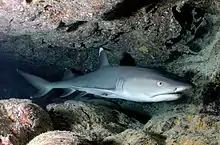
The whitetip reef shark, Triaenodon obesus, is a species of requiem shark, family Carcharhinidae, and the only member of its genus. A small shark usually not exceeding 1.6 m (5.2 ft) in length, this species is easily recognizable by its slender body and short but broad head, as well as tubular skin flaps beside the nostrils, oval eyes with vertical pupils, and white-tipped dorsal and caudal fins. One of the most common sharks found on Indo-Pacific coral reefs, the whitetip reef shark occurs as far west as South Africa and as far east as Central America. It is typically found on or near the bottom in clear water, at a depth of 8–40 m (26–131 ft).
During the day, whitetip reef sharks spend much of their time resting inside caves. Unlike other requiem sharks, which rely on ram ventilation and must constantly swim to breathe, this shark can pump water over its gills and lie still on the bottom. At night, whitetip reef sharks emerge to hunt bony fishes, crustaceans, and octopus in groups, their elongate bodies allowing them to force their way into crevices and holes to extract hidden prey. Individual whitetip reef sharks may stay within a particular area of the reef for months to years, time and again returning to the same shelter. This species is viviparous, in which the developing embryos sustained by a placental connection to their mother. One of the few sharks in which mating has been observed in the wild, receptive female whitetip reef sharks are followed by prospective males, who attempt to grasp her pectoral fin and maneuver the two of them into positions suitable for copulation. Females give birth to 1–6 pups every other year, after a gestation period of 10–13 months.
Whitetip reef sharks are rarely aggressive towards humans, though they may investigate swimmers closely. However, spear fishers are at risk of being bitten by one attempting to steal their catch. This species is caught for food, though there are reports of ciguatera poisoning resulting from its consumption. The International Union for Conservation of Nature (IUCN) has assessed the whitetip reef shark as Near Threatened, noting that its numbers are dwindling due to increasing levels of unregulated fishing activity across its range. The slow reproductive rate and limited habitat preferences of this species renders its populations vulnerable to over-exploitation.
Zebra shark {GA}
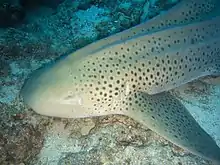
The zebra shark, Stegostoma fasciatum (or varium), is a species of carpet shark and the sole member of the family Stegostomatidae. It is found throughout the tropical Indo-Pacific, frequenting coral reefs and sandy flats to a depth of 62 m (210 ft). Adult zebra sharks are distinctive in appearance, with five longitudinal ridges on a cylindrical body, a low caudal fin comprising nearly half the total length, and a pattern of dark spots on a pale background. Young zebra sharks under 50–90 cm (20–35 in) long have a completely different pattern, consisting of light vertical stripes on a brown background, and lack the ridges. This species attains a length of 2.5 m (8.2 ft).
Zebra sharks are nocturnal and spend most of the day resting motionless on the sea floor. At night, they actively hunt for molluscs, crustaceans, small bony fishes, and possibly sea snakes inside holes and crevices in the reef. Though solitary for most of the year, they form large seasonal aggregations. The zebra shark is oviparous: females produce several dozen large egg capsules, which she anchors to underwater structures via adhesive tendrils. Innocuous to humans and hardy in captivity, zebra sharks are popular subjects of ecotourism dives and public aquaria. The World Conservation Union has assessed this species as Vulnerable worldwide, as it is taken by commercial fisheries across most of its range (except off Australia) for meat, fins, and liver oil. There is evidence that its numbers are dwindling.
Puffadder shyshark {GA}
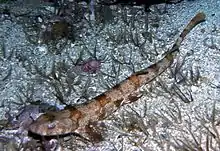
The puffadder shyshark or happy Eddie, Haploblepharus edwardsii, is a species of catshark, family Scyliorhinidae, endemic to the temperate waters off South Africa. This common shark is found on or near the bottom in sandy or rocky habitats, from the intertidal zone to a depth of 130 m (430 ft). Typically reaching 60 cm (24 in) in length, the puffadder shyshark has a slender, flattened body and head. It is strikingly patterned with a series of dark-edged, bright orange "saddles" and numerous small white spots over its back. The Natal shyshark (H. kistnasamyi), formally described in 2006, was once considered to be an alternate form of the puffadder shyshark.
When threatened, the puffadder shyshark (and other members of its genus) curls into a circle with its tail covering its eyes, giving rise to the local names "shyshark" and "doughnut". It is a predator that feeds mainly on crustaceans, polychaete worms, and small bony fishes. This shark is oviparous and females deposit egg capsules singly or in pairs onto underwater structures. Harmless to humans, the puffadder shyshark is usually discarded by commercial and recreational fishers alike for its small size. It has been assessed as Near Threatened by the International Union for Conservation of Nature (IUCN), as its entire population is located within a limited area and could potentially be affected by a local increase in fishing pressure or habitat degradation.
Australian swellshark {GA}
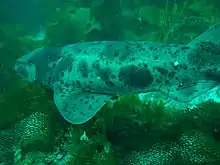
The Australian swellshark or draughtboard shark, Cephaloscyllium laticeps, is a species of catshark, family Scyliorhinidae, endemic to southern Australia. This bottom-dwelling species can be found on the continental shelf down to a depth of 220 m (720 ft). Usually measuring 1 m (3 ft) long, it is a stout-bodied, broad-headed shark with a short tail and a first dorsal fin much larger than the second. It can be identified by its variegated dorsal coloration of brown or gray patches and numerous spots.
Australian swellsharks are sedentary and mainly nocturnal, with most individuals remaining within the same local area throughout the year. It feeds on small crustaceans, cephalopods, and fishes. When threatened, it responds by rapidly taking in water or air to inflate its body, hence the name "swellshark". This shark is oviparous and females lay pairs of distinctively ridged egg capsules at 20–30 day intervals. The eggs hatch after 11–12 months. Harmless and of little commercial interest, many Australian swellsharks are caught incidentally in gillnets and bottom trawls but usually survive to be released because of their extreme hardiness. As a result, the International Union for Conservation of Nature (IUCN) has assessed this species as of Least Concern.
Milk shark {GA}

The milk shark, Rhizoprionodon acutus, is a species of requiem shark, family Carcharhinidae, whose common name comes from an Indian belief that consumption of its meat promotes lactation. The largest and most widely distributed member of its genus, the milk shark typically measures 1.1 m (3.6 ft) long and can be found in coastal tropical waters throughout the eastern Atlantic and the Indo-Pacific regions. Occurring from the surface to a depth of 200 m (660 ft), this species is common near beaches and in estuaries, and has been recorded swimming up rivers in Cambodia. Juveniles are known to inhabit tidal pools and seagrass meadows. The milk shark has a slender body with a long, pointed snout and large eyes, and is a nondescript gray above and white below. This shark can be distinguished from similar species in its range by the long furrows at the corners of its mouth, and 7–15 enlarged pores just above them.
Among the most abundant sharks within its range, the milk shark feeds primarily on small bony fishes but also takes cephalopods and crustaceans. In turn, it often falls prey to larger sharks and possibly marine mammals. In common with other members of its family, this species is viviparous with the developing embryos sustained by a placental connection. Females give birth to 1–8 young either during a defined breeding season or throughout the year, depending on location. The reproductive cycle is usually annual but may be biennial or triennial. Large numbers of milk sharks are caught by artisanal and commercial fisheries in many countries for meat, fins, and fishmeal. Despite this, the International Union for Conservation of Nature (IUCN) has assessed this species as being of Least Concern, because its wide distribution and relatively high productivity seemingly allow present levels of exploitation to be sustained.
Portuguese dogfish {GA}

The Portuguese dogfish or Portuguese shark, Centroscymnus coelolepis, is a species of sleeper shark, family Somniosidae. This globally distributed species has been reported down to a depth of 3,675 m (12,057 ft), making it the deepest-living shark known. It inhabits lower continental slopes and abyssal plains, usually staying near the bottom. Stocky and dark brown in color, the Portuguese dogfish can be distinguished from similar-looking species (such as the kitefin shark, Dalatias licha) by the small spines in front of its dorsal fins. Its dermal denticles are also unusual, resembling the scales of a bony fish. This species typically reaches 0.9–1 m (3.0–3.3 ft) in length; sharks in the Mediterranean Sea are much smaller and have distinct depth and food preferences.
Relatively common, the Portuguese dogfish is an active hunter capable of tackling fast, large prey. It feeds mainly on cephalopods and fishes, though it also consumes invertebrates and cetacean carrion. This shark has acute vision optimized for detecting the bioluminescence of its prey, as sunlight does not reach the depths at which it lives. The Portuguese dogfish is aplacental viviparous, with the young provisioned by yolk and perhaps uterine fluid. The females give birth to up to 29 young after a gestation period of over one year. Valued for its liver oil and to a lesser extent meat, Portuguese dogfish are important to deepwater commercial fisheries operating off Portugal, the British Isles, Japan, and Australia. These fishing pressures and the low reproductive rate of this species have led the International Union for Conservation of Nature (IUCN) to assess it as Near Threatened.
/42
Portal:Sharks/Selected articles/42
- "Rise of the blockbuster". BBC News Online. Retrieved 2006-08-20.
- Wyatt, Justin. (1994) High Concept: Movies and Marketing in Hollywood. Austin: University of Texas Press. ISBN 0-292-79091-0